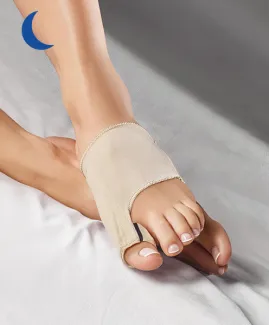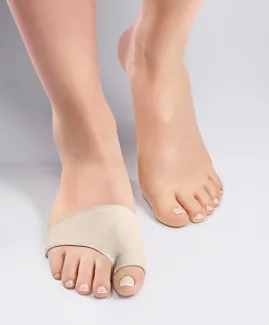
Several signs can warn the start of a bunion on the internal side of the foot like a bump, redness, pain and discomfort in the shoe. Whether mild bunions (deviation of the big toe towards the lesser toes) can be discreet and go unnoticed, their progression is usually more problematic. Identifying the early signs of bunions as soon as possible could then prevent the signs and symptoms from getting worse.
What are the early stages of a bunion? A bunion is starting to form on your foot and you want to know how to stop its progression? EPITACT® answers your questions!
Stage 1: the early signs of bunions start with a bump of the foot
The development of a bunion, also called hallux valgus, can be divided in 4 stages(1): none, mild, moderate and severe.
The first stage (angle inferior to 15°) corresponds to a "normal” foot: no bunion in sight!
The mild bunion corresponds to the beginning of the condition. The angle between the first metatarsal and the first phalanx of the big toe ranges from 15 to 30°.
Lastly, the bunion is said to be “moderate” when the angle ranges from 30 to 40° and “severe” when it goes over 40°(2).
Maybe these first indications yet help you identify the stage of your bunion. To assess the exact angle of the deformity, see a health professional like your GP or podiatrist. X-ray is the only way to precisely view the deviation.
Mild bunions can go with difficulties wearing shoes
For people with a bunion starting on their foot, the bony bump is often considered ungraceful. Even in the case of a mild bunion, this bump that forms on the internal side of the toe can create discomfort, both physically or visually. But the bony protrusion is not always noticeable at the start of a bunion and is commonly not a source of pain.
Even for a small bunion characterised by a discreet bump, some shoes can be very uncomfortable. By deforming the forefoot, it becomes wider and takes more room in the shoe. With this kind of poorly adapted shoes, friction and pressure against the bunion may cause some pain.
Note that the stage of your bunion is not necessarily proportional to your pain! So a mild bunion can be painful just as a moderate or severe bunion can be painless.
Daily discomfort is another early sign of bunions
Indeed, the early signs of a bunion can include redness. When the shoe is inappropriate, the bump rubs against it intensively and repeatedly.
Sometimes, the repeated friction also leads to the inflammation of the synovial bursa that surrounds the joint (bursitis). As a consequence, the bursa can increase in size and redness creates heat and pain. This can decrease your quality of life by restricting your daily activities and impairing your sleep.
Are there risks of complications of mild bunions?
Often benign and painless when it starts, the bunion does not always warn of its progression. However, it has numerous and serious complications:
- Increasing of the angle of the deformity
- Aggravation of pain and friction
- Difficulties in wearing shoes
- Formation of a painful bursitis
- Deformity of the neighbouring toes (claw toes, hammer toes)
- Development of hyperkeratosis areas (calluses, corns)
- Osteoarthritis
- Ingrown toenails
- Joint stiffness of the big toe
- Biomechanical impacts on the joints above (ankle, knee)
You now understand the significance of informing yourself as soon as the early signs of a bunion (ideally before)!
Can pain be limited from the start of a bunion?
It is clear that genetic (heredity), morphological (flat feet) or physiological (gender, age) factors aren’t manageable. However, some actions can help limit the risk of onset or worsening of a mild bunion.
Strengthen your muscles
In particular when a bunion is starting to form, think about muscle strengthening to avoid the deformity to become physically uncomfortable or too advanced. Those exercises aim to fight against imbalance between the big toe muscles, which prevent the development of the early signs of bunions.
Other exercises focus on the big toe joint flexibility. By preserving its mobility, they slow down the progression of the deformity.
Adapt your shoes
You could have the start of a bunion if you wear inappropriate shoes. First, wear more flexible shoes with a wider toe box. Wearing high heels should be prohibited as they’re one of the core reasons explaining the high frequency of this condition in women. Discover what are the best shoes for bunions here!
Protect and correct the deformity as soon as the bunion’s early signs appear
Some devices can help you correct your toe if you have a mild bunion. EPITACT® has created two foot braces that reduce the angle of deviation by holding the big toe straight. Both devices are complementary and allow for a 24-hour action!
- The flexible bunion corrector* is recommended during daily activities as it is totally flexible, so you can wear it in your regular shoes. It straightens the big toe thanks to a silicone tendon and allows better load distribution on the forefoot during walking.
- The rigid bunion corrector* is for night or rest periods only. It includes rigid reinforcements that immobilise the big toe in a specific position. Indeed, they are heat-moldable several times so you can gradually increase the correction of your deformity. They also perfectly adapt to your foot shape.
If you have the start of a bunion, many things can be done to slow down its progression. The range of EPITACT® protections relieve you as soon as the early signs of a bunion appear. If you are at a more advanced stage of bunions, try the bunion protector*. Find out more information about the ways of diagnosing and treating hallux valgus and bunion surgery at the bottom of this page.
*These solutions are class I medical devices that bear the CE marking under this regulation. Carefully read the instructions before use. Manufacturer: Millet Innovation. 09/2023
For more details about this general and simplified approach, here are further sources:
(1)Menz HB, Munteanu SE. Radiographic validation of the Manchester scale for the classification of hallux valgus deformity. Rheumatology. 1 aug 2005;44(8):1061‑6.
(2)Garrow AP, Papageorgiou A, Silman AJ, Thomas E, Jayson MIV, Macfarlane GJ. The Grading of Hallux Valgus. Journal of the American Podiatric Medical Association. 1 feb 2001;91(2):74‑8.
 Pharmacie
Pharmacie

